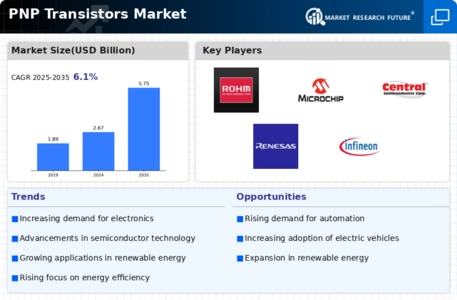Market Growth Projections
The Global PNP Transistors Market Industry is projected to experience substantial growth, with estimates indicating a market value of 2.67 USD Billion in 2024 and a remarkable increase to 5.75 USD Billion by 2035. This growth corresponds to a compound annual growth rate (CAGR) of 7.21% from 2025 to 2035. Such projections reflect the increasing reliance on PNP transistors across various sectors, including consumer electronics, automotive, and renewable energy. As technological advancements continue to shape the landscape, the Global PNP Transistors Market Industry is poised for significant expansion, driven by the demand for efficient and reliable electronic components.
Rise of Renewable Energy Solutions
The Global PNP Transistors Market Industry is positively impacted by the increasing adoption of renewable energy solutions. As countries strive to reduce carbon emissions and transition towards sustainable energy sources, the demand for efficient power conversion systems rises. PNP transistors are integral in solar inverters and wind turbine controllers, ensuring optimal energy conversion and management. This trend aligns with global initiatives aimed at enhancing energy efficiency and sustainability. The anticipated growth in the renewable energy sector further supports the expansion of the Global PNP Transistors Market Industry, as these components become vital in modern energy systems.
Advancements in Automotive Technology
The automotive sector is undergoing a transformation with the integration of advanced electronic systems, which significantly influences the Global PNP Transistors Market Industry. As electric vehicles (EVs) and hybrid vehicles gain traction, the demand for efficient power management solutions increases. PNP transistors are essential in these applications, facilitating better energy efficiency and performance. The automotive electronics market is expected to grow substantially, contributing to the projected growth of the Global PNP Transistors Market Industry, which is anticipated to reach 5.75 USD Billion by 2035. This shift towards electrification in the automotive sector underscores the importance of PNP transistors.
Growing Demand for Consumer Electronics
The Global PNP Transistors Market Industry experiences a surge in demand driven by the increasing consumption of consumer electronics. Devices such as smartphones, tablets, and laptops require efficient power management, where PNP transistors play a crucial role. As the global market for consumer electronics is projected to reach 2.67 USD Billion in 2024, the need for reliable and efficient components like PNP transistors becomes paramount. This trend indicates a robust growth trajectory, as manufacturers seek to enhance device performance and energy efficiency, thereby propelling the Global PNP Transistors Market Industry forward.
Miniaturization of Electronic Components
The trend towards miniaturization in electronics significantly influences the Global PNP Transistors Market Industry. As devices become smaller and more compact, the demand for high-performance transistors that occupy less space increases. PNP transistors, known for their efficiency and reliability, are increasingly utilized in miniaturized applications across various sectors, including telecommunications and consumer electronics. This trend is expected to drive innovation and development within the industry, as manufacturers seek to create smaller, more efficient devices. The growth in miniaturization is likely to contribute to the overall expansion of the Global PNP Transistors Market Industry in the coming years.
Technological Innovations in Semiconductor Manufacturing
Technological advancements in semiconductor manufacturing processes are pivotal for the Global PNP Transistors Market Industry. Innovations such as improved fabrication techniques and materials enhance the performance and efficiency of PNP transistors. These advancements enable manufacturers to produce transistors that meet the growing demands of various applications, from consumer electronics to industrial systems. As the industry evolves, the introduction of new technologies is expected to drive competition and growth within the Global PNP Transistors Market Industry. This dynamic environment fosters continuous improvement and adaptation, ensuring that PNP transistors remain integral to modern electronic systems.









Leave a Comment